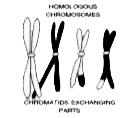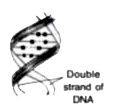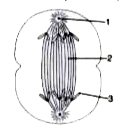Complete Solutions to REVIEW QUESTIONS of chapter CELL CYCLE, CELL DIVISION AND STRUCTURE OF CHROMOSOME of Class 10 book with complete answers and questions
| Class 10 | BIOLOGY |
| Chapter | CELL CYCLE, CELL DIVISION AND STRUCTURE OF CHROMOSOME |
| EVERGREEN PUBLICATION | REVIEW QUESTIONS |
| Number Of Questions | 100 |
| Academic Year | 2023-24 |
The shortest stage of mitosis.
View SolutionThe structure which initiates cell division in animal cell.
View SolutionThe tip of the chromosome which are rounded and sealed.
View SolutionThe type of chromosome whose centromere is in the middle.
View SolutionThe stage of mitosis during which nuclear membrane and nucleolus reappears.
View SolutionA membrane that disappears during late prophase.
View SolutionA pair of chromosomes carrying dissimilar alleles for a particular character.
View SolutionActs as bearer of heredity units.
View SolutionTwo animals which have nineteen pairs of chromosomes.
View SolutionA region of plant body where cell division occurs very actively.
View SolutionStructure that initiates cell division.
View SolutionChromosomes appear thread like.
View SolutionThe type of cell division which occurs in the cells of the reproductive organs.
View SolutionThe exchange of chromatid parts between the maternal and paternal chromatids of a pair of homologous chromosomes during meiosis.
View SolutionThe number of chromosomes present in a nerve cell of a human being.
View SolutionGrowth of cell, synthesis of DNA, synapsis and synthesis of proteins.
View SolutionSynapsis, crossing over, chiasma formation and interkinesis.
View SolutionAster formation, spindle formation, disappearance of nucleolus and formation of equatorial plate.
View SolutionFind the odd one out : Splitting of centromere, formation of daughter chromosomes, reappearance of nucleolus.
View SolutionPhosphate, RNA, Sugar, Nitrogenous base.
View SolutionCentrosome, Cell wall, Cell membrane, Large vacuoles.
View SolutionNuclear envelope disappears.
View SolutionReappearance of nucleolus.
View SolutionFormation of equatorial plate.
View SolutionFormation and movements of asters towards the opposite poles.
View SolutionUncoiling and elongation of chromosomes.
View SolutionSplitting of centromere and movement of daughter chromosomes towards opposite poles.
View SolutionWho coined the terms mitosis and meiosis?
View SolutionName the cell division that takes place during gametogenesis. What is its significance ?
View SolutionPairing of homologous chromosomes is known as ......... and takes place in ........ .
View Solution……………………. is the mutual exchange of corresponding parts of non-sister chromatids.
View SolutionAfter crossing over the points of attachment between non-sister chromatids are called………………… .
View SolutionMeiosis-l is also known as …………… division.
View SolutionThe structure to which both chromatids of a chromosome are attached is known as ?
View SolutionDefine the following terms :
(a) Cell (b) Cell organelle
(c) Mitosis (d) Meiosis
(e) Evolution (f) Crossing -over
(g) Karyokinesis (h) Diploid
(i) Interphase
View SolutionHow mitosis differs in animal and plant cells?
View SolutionDifferentiate between :
Mitosis and Meiosis
View SolutionDifferentiate between :
Centrosome and Centromere
View SolutionHow mitosis differs in animal and plant cells?
View SolutionWhat is cell cycle ? Diagrammatically explain cell cycle
View SolutionWith the help of self explanatory diagrams show the process of mitosis.
View SolutionGive significance of mitosis and meiosis.
View SolutionA cell has 5 pairs of chromosomes। After mitotic division, the number of chromosomes in daughter cell will be
View SolutionThe points where two non-sister chromatids cross-over are called
View SolutionThe point where two sister chromatids of a chromosome are attached is known as
View SolutionWhich of the following is known as post-mitotic phase ?
View SolutionDuplication of chromatin material takes place during
View SolutionMeiosis-I is reductional division. Meiosis-II is equational division due to
View SolutionExplain the structure of an eukaryotic chromosome.
View SolutionWhy is cell division necessary ?
View SolutionThe diagram given below represents a certain phenomenon occurs during meiosis :

Name of the phenomenon
Define the phenomenon
State the difference between chromosome and chromatid
View SolutionGive one point of difference between the following pairs on the basis of what is indicated in brackets:
Metacentric and Telocentric (Centromere)
Centromere and Telomere (Location)
Maternal and Paternal chromosomes (Source)
Allosome and Autosome (Function)
View SolutionThe diagram given below represents a stage of a cell:

Name the stage.
Is it a plant cell or animal cell? Give a logic reason.
Label the parts 1-4
View SolutionDraw a well labelled diagram of metaphasic chromosome.
View SolutionGiven below is a diagram representing a stage during mitotic cell division in an animal cell:

Identify the above stage। Give a reason to support your answer.
View SolutionGiven below is a diagram representing a stage during mitotic cell division in an animal cell:

Name the cell organelle that forms the 'aster'.
View SolutionGiven below is a diagram representing a stage during mitotic cell division in an animal cell:

Name the parts labelled 1, 2 and 3.
View SolutionGiven below is a diagram representing a stage during mitotic cell division in an animal cell:

Name the stage that follows this stage of mitosis. How can this stage be identified ?
View SolutionGiven below is a diagram representing a stage during mitotic cell division in an animal cell:

Mention two points of difference between 'mitosis' and 'meiosis' with regard to :
The number of daughter cells formed.
The chromosome number in the daughter cells.
View SolutionWhat do you understand by karyokinesis and cytokinesis? Mention differences in both of them.
View SolutionDifferentiate between :
Mitosis and Meiosis
View SolutionDifferentiate between :
Differentiate between Tonoplast and Plasma membrane (Location)
View SolutionGametes have a haploid number of chromosomes.
View SolutionDuplicated chromosomes are joined at a point termed (centrosome, centromere, centriole, chromatid).
View SolutionMatch the column A with column B.

View SolutionDraw a neat labelled diagram to show the metaphase stage of mitosis in an animal cell having four chromosomes.
View SolutionHow many daughter cells are formed at the end of mitosis and at the end of meiosis?
View SolutionWith reference to cell division explain the following terms:
Chromatid, Centromere, Haploid.
View SolutionThe given diagram shows a stage during mitotic division in an animal cell:

Name the type of cell division that occurs during:
A. Growth of a shoot
B. Formation of pollen grains.
View SolutionInterphase, Anaphase, Prophase, Telophase, Metaphase. (sequential stage in Karyokinesis).
View SolutionMetaphase , telophase , prophase, anaphase.
View SolutionKaryokinesis, S-phase, cytokinesis, `G_1`-phase, `G_2`-phase (cell cycle).
View SolutionDraw a diagram of the nucleus of a cell, having chromosome number 6, as it would appear in the Metaphase stage of Mitosis and label the following parts in the diagram: Aster Achromatic spindle Chromatid Centromere.
View SolutionCytokinesis is a division of cytoplasm.
View SolutionGene is a specific part of a chromosome that determines hereditary characteristics.
View SolutionDuplicated chromosomes are joined at a point termed (centrosome, centromere, centriole, chromatid).
View SolutionThe number of pairs of autosomes in man is 22.
View SolutionThe resting state in mitosis is called interphase.
View SolutionMitosis is the type of cell division occurring in the cells of injured parts of the body.
View SolutionFill the gaps of the following paragraph taking appropriate words from the bracket (first, second, meiosis, mitosis, 1:1, 1:2, gametes, male, female, 50%, 100%). In human beings male has XY and female has XX chromosome complement. The sex chromosomes segregate during the (a) division of (b)_____ The X-chromosome constitutes (c) _____ of produced sperms and (d)____ of eggs. If randomly mated, the ratio of sex expression is (e) _____. The sex of the offspring is determined by (f)____ of (g) _____.
View SolutionState whether the following statements are True or False. If False rewrite the correct form of the statement by changing the first or last word only:
Lysosomes is a part of the cell in which chromosomes are present
View SolutionState whether the following statements are true or false. If false, rewrite the correct form of the statement by changing the first or last word only:
Centrosome is an organelle of the cell to initiate cell division.
View SolutionGive the specific function of:
(i) Centrosome
(ii) Stoma
(iii) Transpiration
(iv) Ureter
(v) Vitreous humour
View SolutionThe diagram given below represents a stage in cell division. Study the same and answer the questions that follows:

Where does this type of cell division usually occur?
View SolutionStudy the diagram given below and then answer the questions that follow :

State the function of the parts labelled 1,2,3 and 4
View SolutionThe diagram given below represents a stage in cell division. Study the same and answer the questions that follows:

How many daughter cells are formed from this type of cell division ?
View SolutionThe diagram given below represents a stage in cell division. Study the same and answer the questions that follows:

Where does this type of cell division usually occur?
View SolutionThe diagram given below represents a stage in cell division. Study the same and answer the questions that follows:

How many daughter cells are formed from this type of cell division ?
View SolutionThe diagram given below represents a stage in cell division. Study the same and answer the questions that follows:

Is the dividing cell shown a plant or an animal cell? Give a reason to support your answer.
View SolutionGiven below is a diagram of a double helical structure of DNA.

Name the four nitrogenous bases that form a DNA molecule.
View SolutionGiven below is a diagram of a double helical structure of DNA.

Give the full form of DNA.
View SolutionGiven below is a diagram of a double helical structure of DNA.

Name the unit of strand of DNA heredity.
View SolutionGiven below is a diagram of a double helical structure of DNA.

Mention two points of difference between Mitosis and Meiosis.
View SolutionGiven diagram representing a stage during mitotic cell division in an animal cell:

Identify the above stage. Give a reason to support your answer.
View SolutionGiven diagram representing a stage during mitotic cell division in an animal cell:

Name the parts labelled 1, 2, 3 and 4.
View SolutionGiven diagram representing a stage during mitotic cell division in an animal cell:

What is the function of part 3?
View SolutionGiven diagram representing a stage during mitotic cell division in an animal cell:

Name the stage that comes just after the stage shown in the diagram. Draw a well labelled diagram of this stage.
View SolutionThe diagram given below represents a stage during cell division. Study the same and then answer the questions that follow :

Name the parts labelled 1, 2 and 3.
View SolutionThe diagram given below represents a stage during cell division. Study the same and then answer the questions that follow :

Identify the above stage and give a reason to support your answer.
View SolutionThe diagram given below represents a stage during cell division. Study the same and then answer the questions that follow :

Mention where in the body this type of cell division occurs.
View Solution
REVIEW QUESTIONS questions and complete solutions for chapter CELL CYCLE, CELL DIVISION AND STRUCTURE OF CHROMOSOME of EVERGREEN BIOLOGY (ENGLISH) of Class 10